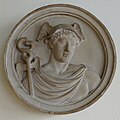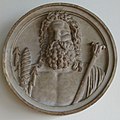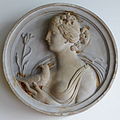Work house (Bremen)
The work house was a building in Bremen .
History of the Bremen workhouses
There was a workhouse in Bremen since 1604/06 as a breeding and work house in Grossenstrasse in Stephaniviertel in what is now Bremen's Mitte district. In 1791 a workhouse was built on the Teerhof in Bremen. In workhouses, simple work was done for low wages, with the help and educational functions being at the fore.
On the so-called Herrlichkeit on the Teerhof in 1739 the Herrlichkeitzwinger and Powder Tower, the so-called bride as part of the Bremen city fortifications , blew up. In 1830 the Senate decided to build a workhouse here.
The building
This workhouse in the classical style, which was built from 1830 to 1831 according to designs by Friedrich Moritz Stamm . It burned down in an air raid in 1944 and was later demolished.
On the Weser side, a five-axis central projection with a flat triangular gable determined the visual impression. The lowest of the three floors had arched windows. In the area of the risalit, the round arches were framed with a total of six sandstone medallions with depictions of ancient gods.
In the building there were working rooms in which simple activities were carried out partly voluntarily and partly as forced labor for a low wage, as well as dining rooms and a bedside room. There was also a “school for poor people's children”.
The workhouse was closed in 1922 and prepared for the new use as a building yard (building administration) of the city. It served this purpose until it was destroyed in 1944.
The sandstone medallions were recovered from the rubble and later attached to a wall in the building senator's new office building in the canteen.
literature
- Herbert Black Forest : The Great Bremen Lexicon . 2nd, updated, revised and expanded edition. Edition Temmen, Bremen 2003, ISBN 3-86108-693-X , p. 35.
- Herbert Black Forest: The Great Bremen Lexicon. Volume: supplementary volume . A – Z. Edition Temmen, Bremen 2008, ISBN 978-3-86108-986-5 , p. 11.
- Werner Kloos , Reinhold Thiel : Bremer Lexikon . 3. Edition. Hauschild Verlag, Bremen 1997, ISBN 3-931785-47-5 , p. 19 .
- Rudolf Stein: Classicism and Romanticism in the Art of Architecture in Bremen , Vol. 1, Bremen 1964, pp. 88–96.
Coordinates: 53 ° 4 ′ 22 " N , 8 ° 48 ′ 11" E






